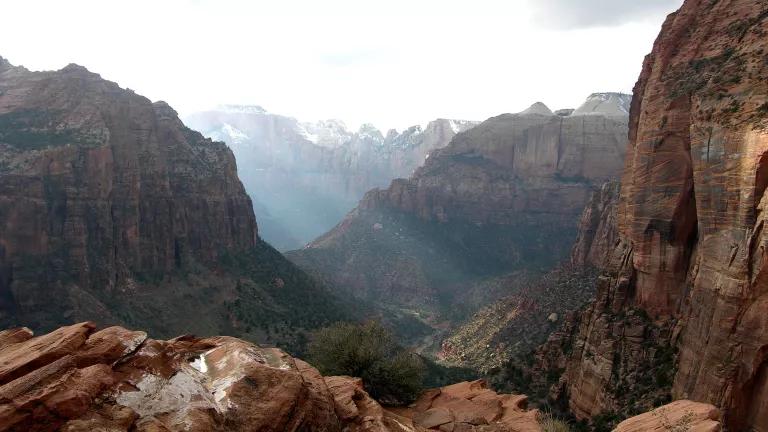Meeting America’s Conservation Goals
America needs a tracking tool to encourage nature protection and access.

Zion National Park
Dr. Igor Smolyar, NOAA/NESDIS/NODC
The administration has committed to develop the country’s first-ever American Conservation and Stewardship Atlas. The Atlas will identify our nation’s conservation baseline and track progress toward the America the Beautiful initiative’s goals of tackling climate change, reducing biodiversity loss, and increasing equitable access to nature. The administration is due to launch a beta version of the Atlas soon, and we will be taking a close look at what it includes.
To deliver on the America the Beautiful initiative's promise, we’ll look to see if this conservation tracking tool:
- Separately tracks progress towards the biodiversity, climate, and access to nature goals. Each of the America the Beautiful goals is critical. Monitoring gains towards each individual goal helps ensure that each receives the attention it deserves.
Identifies the strong, durable actions needed to reach America’s 30x30 target. The science is clear: we must protect more of the planet in its natural state to ensure we avoid hitting “points of no return” for our natural world. A week after his inauguration, President Biden met this challenge and set us on a path to conserve 30 percent of the nation’s land, inland waters, and ocean areas by 2030 (often called “30-by-30” or “30x30”). Guidance for how the administration will achieve this ambitious target is in the America the Beautiful campaign.
Not all conservation actions listed in the Atlas, while they may bring environmental benefits, will contribute to the specific biodiversity goals of the 30x30 target. It is critically important to determine the subset of conservation measures that do contribute to 30x30.
The 30x30 goal must be met with the bold and enduring conservation actions called for by the global scientific community. The Atlas should clearly indicate the conservation measures that can tackle the biodiversity and climate crises effectively and efficiently.
For example, in the ocean, science shows that fully and highly protected marine protected areas (MPAs) are far more effective than other methods at conserving biodiversity, protecting ecosystem structure and function, and enhancing ecosystem resilience. We need to create more of these strongly protected areas across a diverse array of ocean habitats in order to reach our 30x30 goal. On land, it’s equally important that meaningful protections exist in perpetuity—either through public land designations that provide this (e.g., national monuments, wilderness, and national conservation areas) or by permanent conservation easements on private lands.
- Provides a public input process. As with all beta versions of new tools, changes will be needed to the draft Atlas. The administration should explain how it will engage the public in discussions on this draft version, and the next steps to finalize the tool—and keep it fresh. It’s essential that the Atlas be regularly updated to help empower stakeholders to advocate for greater protections across a full range of ecosystems and landscapes.
The Atlas offers us the opportunity to plan together for a brighter, more resilient future. Providing places for wildlife and habitat to thrive and also recover from various stresses strengthens communities’ natural resilience in the face of climate change, yielding huge dividends in a climate-stressed world. Conserving areas key to communities’ ability to connect to the natural world—and each other—is essential.




